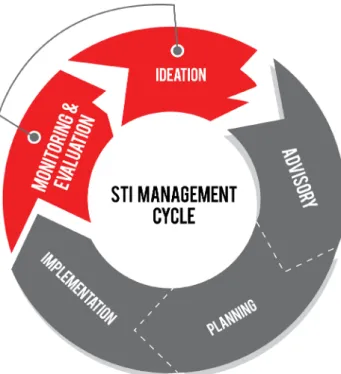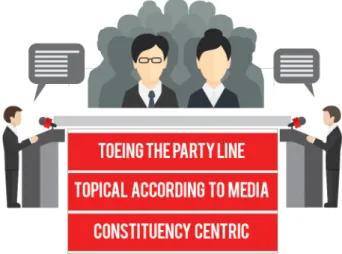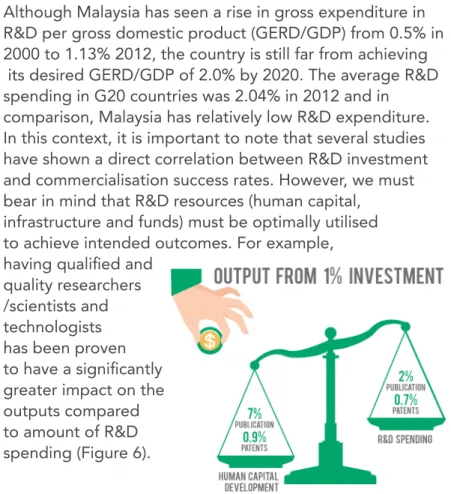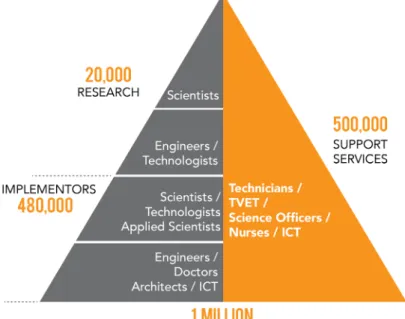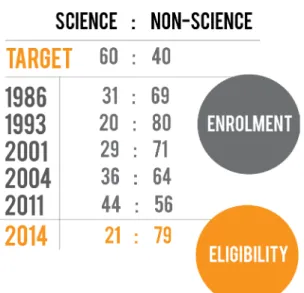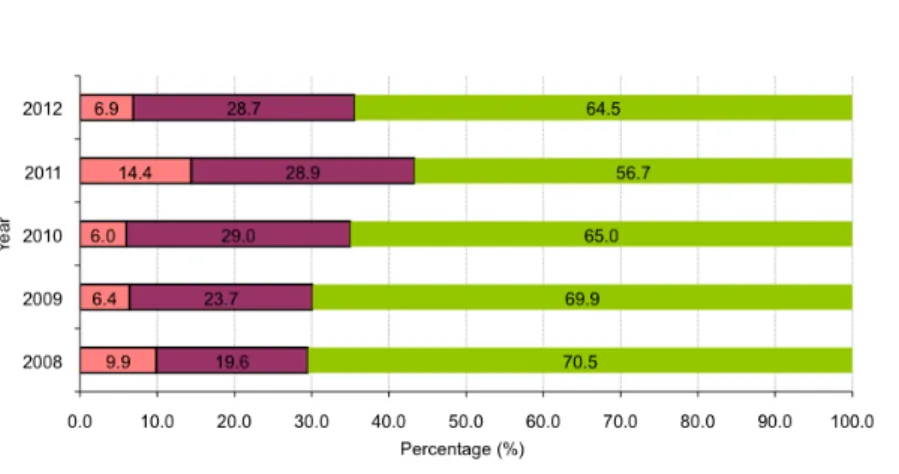I believe that the ASM Science Outlook 2015 is a strategic document that offers a timely insight into Malaysia's STI landscape and the way forward.” The Science Outlook marks a new beginning in the effort to take Malaysia's STI development to the next level. ASM is pleased to announce the first Malaysian Science Outlook, an independent review of key trends in science, technology and innovation in Malaysia.
I hope that this Science Outlook will facilitate the utilization of STI for national development and global competitiveness.” The Science Outlook provides a reality check based on the 6 strategic driving forces of the National Policy on Science, Technology and Innovation NPSTI) (Figure 1). The Science Outlook provides insights and fresh perspectives on the Malaysian STI landscape with relevant supporting data in the spirit of promoting informed, evidence-based decision-making.
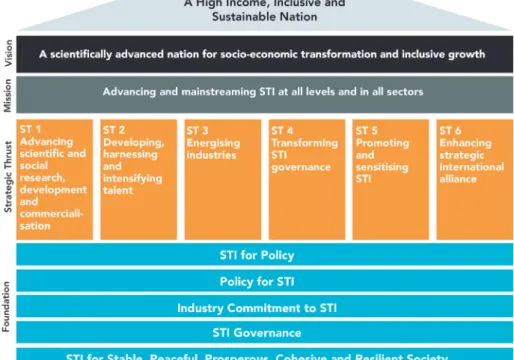
An enabling environment for effective STI Governance
The proposed Science (Malaysia) Act will be instrumental in establishing a strong institutional framework for science governance.
SELECT COMMITTEE
Does R,D&C address national priorities, challenges and opportunities?
Another observation of the Malaysian R,D,C&I landscape is that government ministries often assume the role of policy makers and implementers. One of the major problems identified in the R,D&C value chain in Malaysia is fragmented research activities. There is no single, cross-cutting coordinating body that transcends all ministries to effectively implement the nation's R,U,C&I activities.
Against such a background, a long-term R,D&C perspective is often sidelined in the pursuit of quick wins and low-hanging fruit. To fully realize an innovation-led economy in the nation, F,D,C&I must go beyond mere returns. One way to achieve this would be for the government to empower an existing centralized body to act as a research council or cross-ministerial research management agency to promote smooth implementation, governance and monitoring of R&D&C&I.
Such an entity should be given the mandate and necessary resources to effectively and efficiently manage public R, R, C&I. May conduct planning, coordination, and monitoring of publicly funded R, R, C&I projects, conduct technology foresight studies, identify national priority areas, and promote interdisciplinary and multi-agency research efforts. A much-needed centralized database of R, R, C&I schemes, grants and research activities can also be established and effectively maintained through this entity.
Multiple efforts and initiatives must be brought together to nurture a holistic and robust R,D,C&I ecosystem to tackle intertwined challenges affecting people, planet and profit. Only then can we successfully translate public and private investments in R,D,C&I to socio-economic impact in Malaysia.
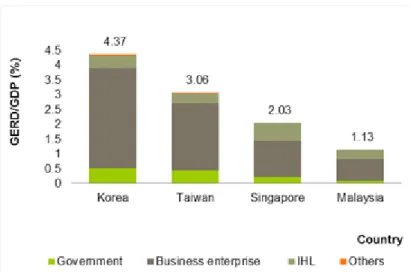
Measures to build capacity and establish the socio-economic impact of Malaysian R,D&C
EMPOWER CENTRALISED
BODY
EFFECTIVE USE
03 STI TALENT
How is Malaysia positioned with regards
The talent we see in the market today is a product of 20 or 30 years ago. Despite many efforts and significant investment in STEM education, interest in science and mathematics appears to be declining, contributing to the depletion of STI talent. Some of the reasons that could contribute to the decline in interest in science and mathematics are ad hoc changes in
Something must be done now to inculcate, nurture and develop the interest of students in science and technology. These students may also become less and less interested in school, unless a conducive ecosystem is created that stimulates their interest to engage and sustain them in the science stream. About 41% of science teachers in the country do not hold a bachelor's degree, with 37.13% holding only SPM/STP qualifications and 3.75% holding diplomas.
The program requires at least three honors at SPM level, but 70% of those offered a place on the program do not achieve this. Only 3% of offers were received by candidates who were considered successful (World Bank, 2013). For example, according to the US Department of Commerce, not only are STEM occupations growing faster in the country (at 17%) than.
For Malaysian talent to thrive and contribute effectively to the nation, there must be a sustained exercise to position the right opportunities and incentives through a rewarding and professional environment. The way forward would be to adopt the Science and Technology Human Capital Roadmap for systematic planning and development of STI Talent.
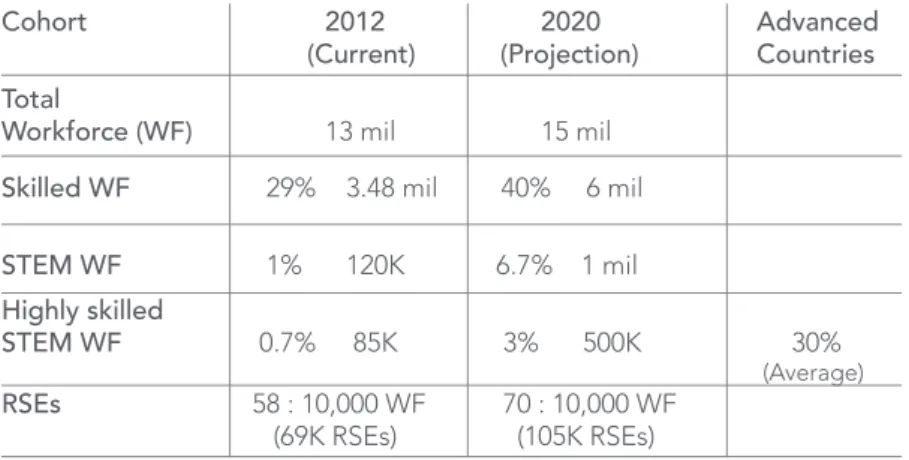
Developing, harnessing and intensifying talent
04 ENERGISING INDUSTRIES
How engaged are our Industries in existing STI frameworks?
In this context, the fundamental question is how industries in Malaysia are included in the national STI agenda to contribute positively to the advancement of national priorities. A 2014 industry perception audit conducted by ASM found that industry is poorly aware of existing STI policy frameworks and the sources and criteria for research funding. Another two-thirds were either not aware of such policies or were unsure about the policies associated with them (Figure 10).
These findings are consistent with a 2008 survey in which the industry viewed customers, suppliers and competitors as the three main external sources of innovation information, viz. poor knowledge of policy measures, action plans and incentives prevents industry actors from fully contributing or participating in national STI initiatives (Figure 6). Industry is often disconnected from many aspects of the national STI agenda due to the minimal involvement of industry in the very process of strategy formulation of national STI policies and frameworks, the lack of effective two-way communication platforms and the absence of a comprehensive national database of relevant STI information for industry reference.
There is also a need for aggressive and continuous information channels to disseminate the focus areas of the national STI agenda to industry players to increase understanding, engagement and engagement. Malaysia's rankings in knowledge-based workforce, innovation linkages and knowledge and technology output declined between 2011 and 2014. It is valuable to understand what really motivates business or industry players in general to invest significantly in R&D or STI initiatives.
As such, one of the main motivating factors to carry out R&D is the availability of public funds for R&D. An ecosystem that will motivate the industry to undertake more R&D and contribute significantly to Malaysia's STI Agenda.

An ecosystem that will motivate the industry to undertake more R&D and to contribute significantly to the STI Agenda of Malaysia
PARTNERSHIP
TO DISSEMINATE STI AGENDA
AMONGST INDUSTRY
PLAYER
STI DATA CENTRE
05 STI ENCULTURATION
Is STI exciting and meaningful to the society?
Further cause for concern is the low knowledge of STI among Malaysians with only 46% able to correctly answer an STI factual knowledge survey in 2014. Despite multiple efforts by the government and inculcation through the education curriculum, the public's average knowledge levels of STI have hovered. below 50% over the past 16 years (1998 to 2014). To further strengthen the STI enculturation process, since 2013 the Government through the NPSTI has introduced four measures to popularize STI among the public: Establish an advisory body to guide STI public awareness and promotions; Expand and empower science centers to popularize STI in society; Promote STI among schools.
Volunteer Scheme, Young Inventors Challenge, etc.) in Malaysia that have been successful in imparting scientific knowledge, strengthening scientific research, innovation and communication among future citizens and professionals in the country. However, these programs could be even more effective if there was sustained monitoring of the improvement of society's understanding of SPI beyond a mere cursory understanding of the technology in everyday life. In order to maintain the BTI enculturation process in the country, a strategic, long-term BTI enculturation plan must be drawn up.
This plan should recommend early exposure to science in schools, ways to popularize science to the community, and strategies to engage the public using multiple platforms. Government, scientists, prosumers, business, media, parents and young people and society at large) and the platforms for public engagement, including the frequency and content to popularize science among the non-scientific community. The government should promote the enculturation of knowledge-enhancing applications and content so that society can move from being mere consumers to prosumers.
There is also a need to introduce an STI inculturation index to meaningfully measure the level of STI inculturation in society. STI enculturation plan to facilitate and sustain the STI enculturation process in the country.
STI Enculturation Plan to enable and sustain the process of STI enculturation in the country
EARLY EXPOSURE
PLAYERS IN POPULARISING
SCIENCE
ENGAGE PUBLIC THROUGH
DEVELOP SCIENCE
INDEX
06 STRATEGIC INTERNATIONAL ALLIANCE
Can Malaysia tap into global opportunities through strategic STI collaborations?
The need for strengthening strategic international alliances was not articulated or emphasized in Malaysia's original S&T frameworks, at least not until the current policy was introduced. However, we are now on the right track and are in sync with developments in the world. According to the Ministry of Foreign Affairs, Malaysia has signed 108 multilateral treaties, but only 15.7% or 17 of the treaties are STI-related (Figure 13).
In this context, effective positioning of Malaysia's STI knowledge, competencies and infrastructure is necessary to be considered as a strong potential partner in the regional and global arena. The regional integration of the 10 ASEAN member countries into a single market under the ASEAN Economic Community (AEC) in 2015 is certainly a great opportunity for Malaysian industries to strategically position themselves and highlight their ICT competencies. However, ASEAN is clearly not a homogenous group as there is wide variation in the level of STI skills among member states, as well as great diversity spanning culture, religion and language.
Effective cooperation would enable us to avoid competing with each other in the same areas. In the case of MIST and BRICS, which are members of the G20 (an international forum of governments and central bank governors from 20 major economies) and include a mix of the world's largest advanced and emerging economies, an analysis of socio-economic indicators shows that Malaysia is on level. Given the multipolar world of science, for greater impact, multilateral partnerships should be prioritized as emphasized in the report "Knowledge, Networks and Nations: Global Scientific Collaboration in the 21st Century" by the Royal Society UK.
Scientists should be positioned as torchbearers to foster international scientific collaborations toward acquiring, sharing, and using knowledge located anywhere in the world to meaningfully connect the scientific community and their efforts. The basis for targeting such partners cannot be limited to just the objectives of researchers or government, but is in the best interest of advancing the country's STI agenda.
Identifying and establishing practical models for strategic international alliances
INCREASE STI-FOCUSED
ALLIANCE
POSITION MALAYSIA'S
TO STRATEGIC PARTNERS
CONCLUSION

